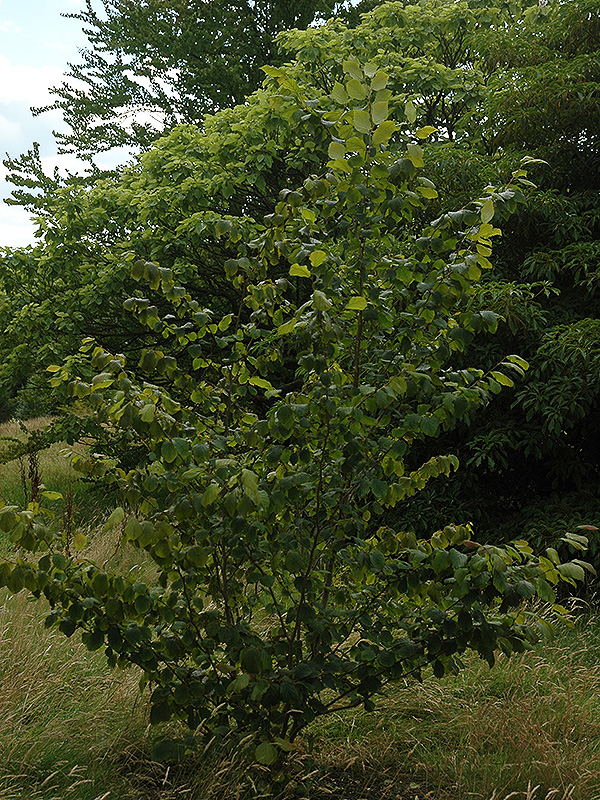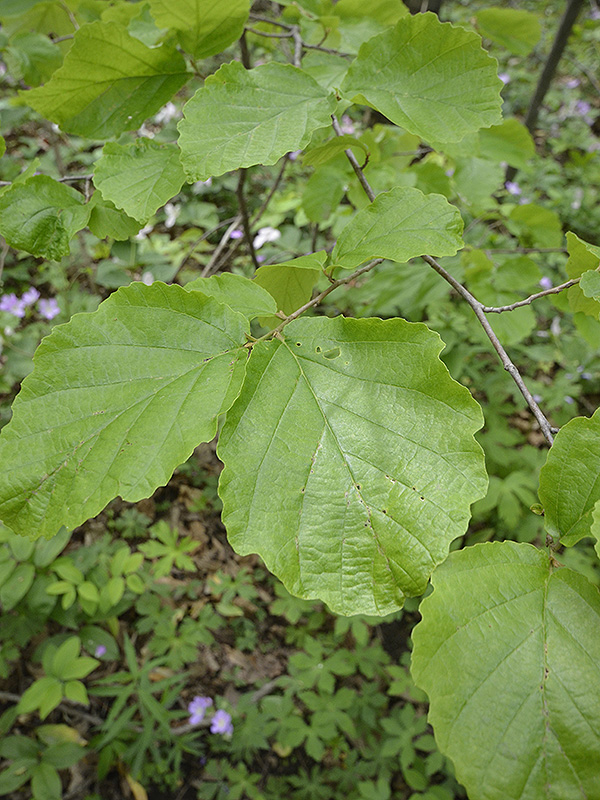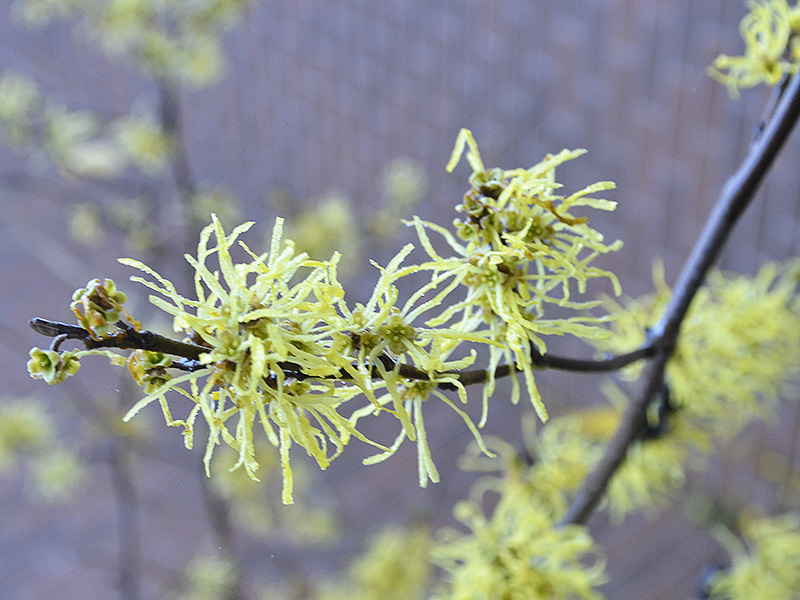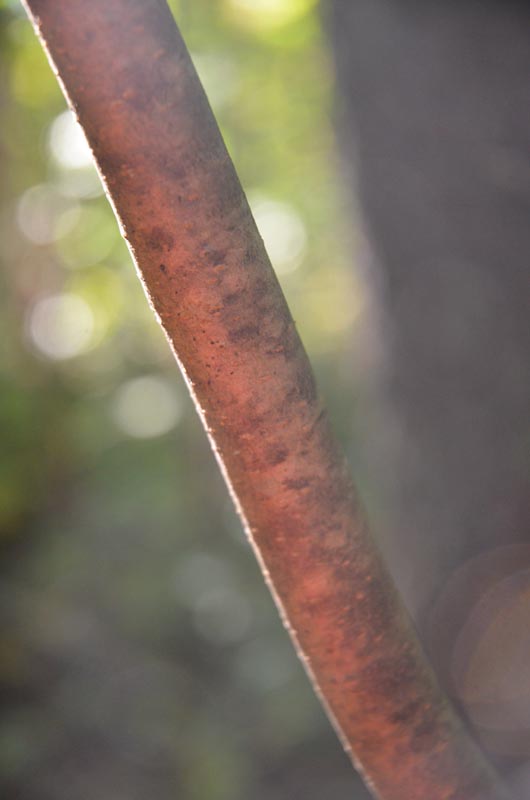
Woody > Hamamelis > Hamamelis virginiana > Hamamelis virginiana
Hamamelis virginiana
Common Witch Hazel or Hamamelis
Origin: Eastern North America.
Mike's
Opinion


"
Common witch hazel is a large, native shrub to small tree. It has unique yellow flowers consisting of four crinkled petals which give off a subtle scent when in bloom. Leaves are usually a clear green and turn a vibrant yellow in autumn. Unfortunately this takes away from the effectiveness of the flowers, as the leaves mask the late autumn blooms. Witch hazel is also used frequently for medicinal purposes; the leaves and bark are harvested and processed into extracts, tinctures and creams used to reduce swelling and as an additive to various skin products.
Michael Pascoe, NDP., ODH., CLT., MSc. (Plant Conservation)
"
| Family |
| Hamamelidaceae |
| Genus |
| Hamamelis |
| Species |
| virginiana |
| Category |
| Woody |
| Type |
| Tree (deciduous), Shrub (deciduous) |
| Pronunciation |
| USDA Hardiness Zone |
| 3 - 8 (9) |
| Canadian Hardiness Zone |
| 4 - 9 |
| RHS Hardiness Zone |
| H7 |
| Temperature (°C) |
| -4 |
| Temperature (°F) |
| 24 |
| Height |
| 4.5 - 6 m |
| Spread |
| 4.5 - 6 m |
Photographs
Description and Growing Information
Flowering Period
| General Description |
| Common witch hazel is a large shrub often considered a small tree with several large, twisted, scattering branches forming an irregular, rounded open crown creating an interesting silhouette. |
| Landscape |
| Common witch hazel is best used for naturalization of landscapes since it is native plant with an unkempt form. It is most suited to shrub borders around large buildings however, because of its large size it is not suited to small residential landscapes. |
| Cultivation |
| It can be grown in full sun or shade but thrives in light to partial shade. Soil should be kept moist since it does not tolerate dry soils. It is a slightly urban tolerant species if the soil and site conditions are met. |
| Shape |
| The shrub has an unevenly, rounded, open crown. |
| Growth |
| Medium |
| ID Characteristic |
| Hamamelis virginiana is as tall as it is wide plant and has many jagged branches, making it look somewhat disheveled. It has unique yellow flowers, arranged in cymes that are aromatic and consist of four crinkled petals. It flowers from the middle of October to late December. |
| Pests |
| There are no serious pests. However, when planted near birch trees aphids can make small galls on the upper leaf surface. Also, phytophthora ramorum can induce leaf lesions and twig dieback. |
| Habitat |
| Common witch hazel prefers moist shaded areas and is often found growing alongside rivers, creeks or streams. Is also commonly found growing in the shade of other plants around the edges of woodlands as an understory plant. |
| Bark/Stem Description |
| The mature growth of the witch hazel is smooth gray to grayish brown. |
| Flower/Leaf Bud Description |
| The lateral buds are a stark brown. The terminal bud is 5 - 10 mm long. Flower buds are stalked, globose, emerging in autumn, there are generally 3 - 4 buds on a crooked stalk. |
| Leaf Description |
| The leaves are alternate, simple, obovate or elliptic, .95 - 1.95 cm wide, obtusely short-acuminate or obtusish, narrowed toward the base and subcordate, rarely broad-cuneate, coarsely crenate-dentate, medium to dark green, can be glabrous or pubescent on the veins on underside of leaf, with 5 - 7 pairs of veins; petiole 5 - 10 mm long, pubescent; leaves slender. |
| Flower Description |
| The flowers are a vibrant yellow, fragrant, with four long crumpled petals, each 1 - 2 cm long. Calyx lobes are yellowish to reddish brown inside. Flowers are borne in 2 - 4 flowering cymes, and last 2 - 4 weeks depending on weather. Flowering and autumn colour often occur simultaneously, significantly reducing the impact of the flowers as they are masked by the yellowing autumn foliage. |
| Fruit Description |
| The fruit is a capsule: 1 cm long, pubescent, dehisces at the distal end, with sharp curved points. The seeds are not discharged until 12 months after flowering. |
| Colour Description |
| Throughout the year the leaves are a medium green changing to a striking golden yellow in autumn. The flowers are bright yellow and have a tendency to blend with the leaves when in autumn. The buds are a plain brown colour. The fruit is a greenish brown when developing, and then turns to a brown colour as it loses moisture. |
| Texture Description |
| The common witch hazel is regarded as medium-coarse in leaf and in winter habit. It has a tendency towards openness, but still makes it an appealing shrub. |
| Notable Specimens |
| Missouri Botanical Gardens, St. Louis, Missouri, United States of America. Joany’s Woods, West Williams, Middlesex County, Ontario, Canada. |
| Propagation |
| From seed after double stratification for 60 days at 20 °C plus 90 days at 5 °C. This process breaks down the outer coat of the seed, without this process the seed will usually not germinate. Root cuttings have 2 - 5% chance of success; young softwood cuttings (3 - 5 years old) yield much better results at 80%. |
References
Dirr, Michael A. 'Manual of Woody Landscape Plants. Vol. 6.' Champaign, Illinois: Stipes publishing, 1975. Print.
Dirr, Michael A. 'Dirr’s Hardy Trees and Shrubs.' Portland, Oregon: Timber Press, 1997. Print.



